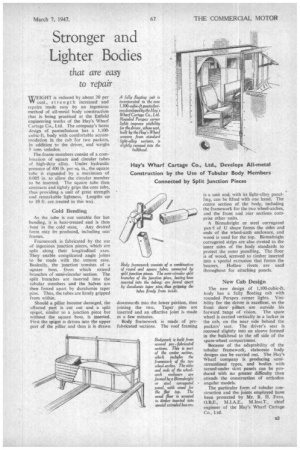Stronger and Lighter Bodies
Page 37

If you've noticed an error in this article please click here to report it so we can fix it.
that are easy to repair
Hay's Wharf Cartage Co., Ltd., Develops All-metal Construction by the Use of Tubular Body Members Connected by Split Junction Pieces VUE1GHT is reduced by about 30 per VI" cent., St r en gt h increased and repairs made easy by an ingenious method of all-metal body construction that is being practised at the Enfield engineering works of the Hay's Wharf Cartage Co., Ltd. The company's latest design of pantechnicon has a 1,100cubic-ft. body with comfortable accommodation in the cab for two packers, in addition to the driver, and weighs 3 tons unladen.
The frame members consist of a combination of square and circular tubes of high-duty alloy. Under hydraulic pressure of 400 lb. per sq. in., the square tube is expanded by a maximum of 0.005 in. to allow the circular member to be inserted. The square tube then contracts and tightly grips the core tube, thus providing a unit of great strength and remarkable lightness. Lengths up to 10 ft. are treated in this way.
Cold Bending
As the tube is not suitable for hot bending, it is heat-treated and is then bent in the cold state. Any desired form May be produced, including seat frames. Framework is fabricated by the use of ingenious junction pieces, which are split along their longitudinal axes. They enable complicated angle joints to be made . with the utmost ease. Basically, the junction consists of a square boss, from which extend branches of semi-circular section. The split branches are inserted into the tubular members and the halves are then forced apart by duralumin taper pins. Thus, the tubes are firmly gripped from within.
Should a pillar become damaged, the affected part is cut out and a split spigot, similar to a junction piece but without the square boss, is inserted. First the spigot is driven into the upper part of the pillar and then it is drawn downwards into the lower portion, thus joining the two. Taper pins are inserted and an effective joint is made in a few minutes.
Body framework is made of prefabricated sections. The roof framing
is a unit and, with its light-alloy panelling, can be lifted with one hand. The centre section of the body, including the framework for the two wheel-arches, and the front and rear sections comprise other units.
A Birmabright or steel corrugated pan-1 of U shape forms the sides and ends of the wheel-arch enclosure, and wood is used for the top. Birmabright corrugated strips are also riveted to the inner sides of the body standards to protect the outer panelling. The floor is of wood, screwed to timber inserted into a special extrusion that forms the bearers. Hollow rivets are used throughout for attaching panels.
New Cab Design The new design of 1,100-cubic-ft. body has a fully floating cab with rounded Perspex corner lights. Visibility for the driver is excellent, as the front door pillars are outside his forward range of vision. The spare wheel is carried vertically in a locker in the cab, on the near side behind the packers' seat. The driver's seat is recessed slightly into an alcove formed in the bulkhead to the off side of the spare-wheel compartment.
Because of the adaptability of the tubular framework, elaborate body designs can be carried out. The Hay's 'Wharf company is producing semistreamlined types, and bodies with turned-under skirt panels can be produced with no greater difficulty than attends the construction of orthodox angular models.
The particular form of tubular construction and the joints employed have been protected by Mr. R. H. Faro, 0.!.F., M.Inst.T., chief engineer of the Hay's Wharf Cartage Co., Ltd.












































































